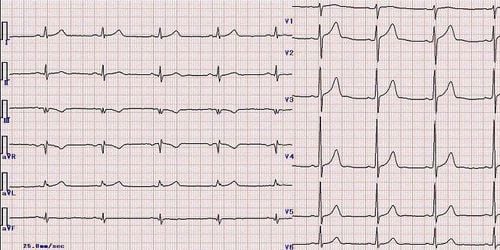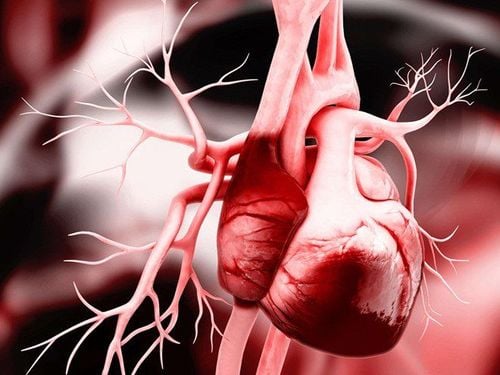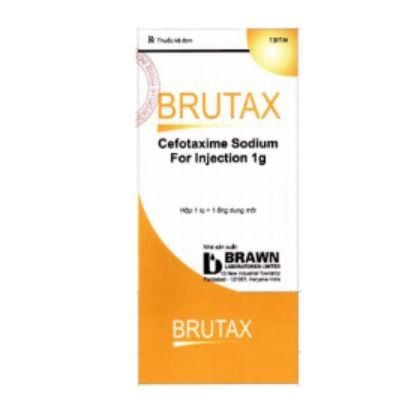This is an automatically translated article.
The article is professionally consulted by Interventional Cardiologists, Department of Medical Examination & Internal Medicine - Vinmec Hai Phong International General Hospital.Pericarditis (VMNT) is an acute disease requiring rapid diagnosis and emergency management. If diagnosed late, it can lead to death in case of acute cardiac tamponade or poor prognosis in constrictive VA. The disease is more common in men than in women
1. What is acute pericarditis?
Pericarditis is a disease that occurs when the lining around the heart becomes inflamed, causing chest pain and the formation of pericardial fluid. The pericardium covers the heart and the proximal portion of the great arteries and veins that arise from the heart. The MNT consists of two leaves: the visceral leaf is the inner membrane adjacent to the myocardial epithelium, the parietal leaf consists of the inner membrane and the fibrous membrane. Normally contains 35-50 ml of fluid with little albumin, which is secreted by mesenchymal cells in the inner membrane of the pericardium. The disease has two forms: acute pericarditis (occurs suddenly) or chronic (occurs continuously for a long time).Acute pericarditis can cause the pericardium to scar, thin, and constrict the heart. The disease has the potential to cause many other symptoms, such as reduced blood flow from the heart. This happens when too much fluid builds up in the pericardium, creating so much pressure on the heart that it cannot pump as full of blood as it should. In severe cases, the patient's blood pressure can drop to dangerous levels, leading to death.

Khi màng quanh tim bị viêm được gọi là bệnh lý viêm màng ngoài tim
2. Causes of acute pericarditis
A many different organs such as respiratory system, digestive system, eyes, urinary tract), hepatitis, .. Bacteria: pneumococcus, streptococcus, staphylococcus,... Tuberculosis (Mycobacterium tuberculosis) Fungi: strains of Histoplasmosis, Coccidioidomycosis, Aspergillosis Parasites: such as Toxoplasmosis, Echinococcus. Having autoimmune disease or some other diseases: Dressler syndrome, late myocardial infarction syndrome,... Connective tissue disease and inflammatory diseases such as lupus erythematosus, rheumatoid arthritis,... Due to effects use of drugs, including procainamide, hydralazine, isoniazid,... Post-heart transplant patients Cancer: primary, secondary, post-radiation cancer Metabolic problems: high blood urea, hypothyroidism, increased blood cholesterol, gout Due to trauma: closed chest trauma, broken heart, broken great artery,... Dissection of the aorta3. Clinical symptoms of acute pericarditis
3.1. Functional symptoms Chest pain is a common symptom of acute pericarditis, the pain is usually behind the sternum, sharp pain, can be severe, but there are also cases of dull pain lasting all day, Pain often radiates to the neck and back. In addition, symptoms of chest pain are often accompanied by fever and muscle aches, similar to a common viral infection. Patients with acute pericarditis sometimes experience dyspnoea, but this usually occurs after a period of chest pain (the disease progresses to pericardial effusion). Feelings of discomfort, stress, sadness. 3.2. Physical symptoms Auscultation of the heart is a diagnostic sign. Accordingly, patients with acute pericarditis, when listening to the heart, will see a rubbing sound coming from the pericardium. The best place to hear the pericardial rub is low on the left sternal border, which can be heard when the patient is asked to sit slightly forward and hold the breath after taking a deep breath.
4. Subclinical signs help diagnose acute pericarditis
4.1. Electrocardiogram (ECG) The ECG of acute pericarditis will progress through 4 stages as follows:
Early stage of the disease: Usually within a few hours after the first chest pain appears. On the ECG observed the following signs: ST segment elevation in the same direction as the positive T wave in the precordial leads Second stage: Appears after a few days, at this time the ST segment returns to the isoelectric line, the T wave flattens Stage three of acute pericarditis, ECG observes negative T wave inversion. Stage after days to weeks: T wave becomes positive again, also the final stage of the disease.

Điện tâm đồ như một tiêu chuẩn chẩn đoán chính cho các bệnh lý tim mạch
4.3. Perform blood culture, sputum culture, and gastric aspiration This test is capable of diagnosing some complicated cases of pericarditis with causes such as tuberculosis (after 1 week), sepsis and inflammation infective endocarditis.
4.4. Blood tests When conducting blood tests for patients, doctors often observe the phenomenon of leukocytosis, increased erythrocyte sedimentation rate, and elevated creatine phosphokinase MB.
4.5. Echocardiography For acute pericarditis, echocardiography is usually indicated at a later stage. At this time, on ultrasound will see a space caused by pericardial fluid, more rarely, it may be a sign that the pericardium is thicker than normal.
4.6. Other tests Transesophageal echocardiography, computed tomography, and nuclear magnetic resonance imaging may be used in some isolated cases to better study the pericardium.
5. Treatment of acute pericarditis
5.1. Medical treatment In patients with acute non-viral pericarditis, specific treatment is to treat the cause. The majority of patients with acute endocarditis respond well to medical treatment. However, patients with large pericardial effusions with hemodynamic disturbances (dyspnea, tachycardia, hypotension), suspected infection or neoplasm, and evidence of constriction of the pericardium should be considered. treated with invasive measures: drainage or pericardiotomy.
5.2. Cardiac surgery For pericarditis caused by cancer, the doctor conducts open surgery to drain the pericardium below the sternum. For patients with recurrent effusion or constrictive pericarditis, the doctor will surgically remove the pericardium.
During the course of treatment, patients with acute pericarditis should pay attention to follow-up appointments on time, adhere to medication, and focus on resting and avoiding strenuous activities.
Acute pericarditis, if diagnosed and treated early, can reduce the risk of dangerous complications.
To help patients determine the cause, complications and grade of pericarditis, Vinmec International Hospital now has a Cardiovascular Screening Package - Basic Cardiovascular Examination, for the following subjects: Cold limbs ; heart palpitations; Rapidly breath; Anxiety, insomnia; Shoulder, wrist pain; Unexplained fatigue; Sweating, indigestion; Swollen feet; Frequent migraines; There is a feeling of tightness when walking; Family with heart disease...
Advantages of cardiovascular screening at Vinmec International General Hospital include:
Medical team - doctors are leading experts, highly qualified , dedicated and wholeheartedly for the benefit of the patient, bringing high efficiency in medical treatment; Comprehensive and professional medical examination, consultation and treatment services; System of modern equipment, supporting effective diagnosis and treatment; Modern, civilized, luxurious and sterile medical examination and treatment space.
Please dial HOTLINE for more information or register for an appointment HERE. Download MyVinmec app to make appointments faster and to manage your bookings easily.













